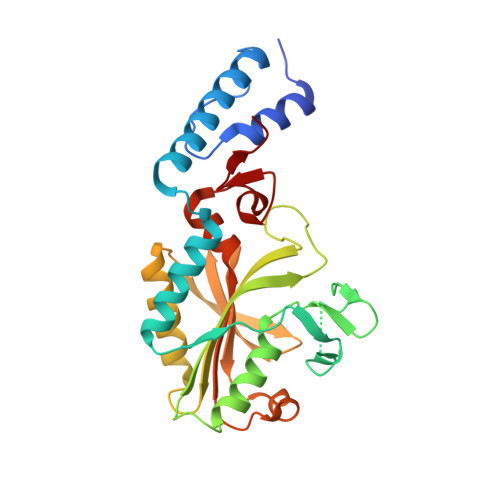Structural Basis for Genetic-Code Expansion with Bulky Lysine Derivatives by an Engineered Pyrrolysyl-tRNA Synthetase.
Yanagisawa, T., Kuratani, M., Seki, E., Hino, N., Sakamoto, K., Yokoyama, S.(2019) Cell Chem Biol 26: 936
- PubMed: 31031143
- DOI: https://doi.org/10.1016/j.chembiol.2019.03.008
- Primary Citation of Related Structures:
6AAC, 6AAD, 6AAN, 6AAO, 6AAP, 6AAQ, 6AAZ, 6AB0, 6AB1, 6AB2, 6AB8, 6ABK, 6ABL, 6ABM - PubMed Abstract:
Pyrrolysyl-tRNA synthetase (PylRS) and tRNA Pyl have been extensively used for genetic-code expansion. A Methanosarcina mazei PylRS mutant bearing the Y306A and Y384F mutations (PylRS(Y306A/Y384F)) encodes various bulky non-natural lysine derivatives by UAG. In this study, we examined how PylRS(Y306A/Y384F) recognizes many amino acids. Among 17 non-natural lysine derivatives, N ɛ -(benzyloxycarbonyl)lysine (ZLys) and 10 ortho/meta/para-substituted ZLys derivatives were efficiently ligated to tRNA Pyl and were incorporated into proteins by PylRS(Y306A/Y384F). We determined crystal structures of 14 non-natural lysine derivatives bound to the PylRS(Y306A/Y384F) catalytic fragment. The meta- and para-substituted ZLys derivatives are snugly accommodated in the productive mode. In contrast, ZLys and the unsubstituted or ortho-substituted ZLys derivatives exhibited an alternative binding mode in addition to the productive mode. PylRS(Y306A/Y384F) displayed a high aminoacylation rate for ZLys, indicating that the double-binding mode minimally affects aminoacylation. These precise substrate recognition mechanisms by PylRS(Y306A/Y384F) may facilitate the structure-based design of novel non-natural amino acids.
Organizational Affiliation:
RIKEN Structural Biology Laboratory, 1-7-22 Suehiro-cho, Tsurumi, Yokohama 230-0045, Japan; Laboratory for Nonnatural Amino Acid Technology, RIKEN Center for Biosystems Dynamics Research, 1-7-22 Suehiro-cho, Tsurumi, Yokohama 230-0045, Japan. Electronic address: [email protected].



















